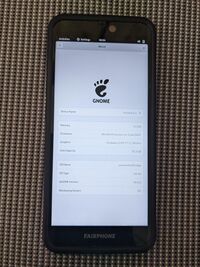Fairphone 3 (fairphone-fp3)
Appearance
 | |
| Manufacturer | Fairphone |
|---|---|
| Name | 3 |
| Codename | fairphone-fp3 |
| Model | FP3 |
| Released | 2019 |
| Type | handset |
| Hardware | |
| Chipset | Qualcomm Snapdragon 632 (SDM632) |
| CPU |
4x 1.8 GHz Kryo 250 Gold 4x 1.8 GHz Kryo 250 Silver |
| GPU | Adreno 506 |
| Display | 1080x2160 |
| Storage | 64 GB |
| Memory | 4 GB |
| Architecture | aarch64 |
| Software | |
Original software The software and version the device was shipped with. |
Android 9 (Linux 4.9) |
Extended version The most recent supported version from the manufacturer. |
Android |
| postmarketOS | |
| Category | testing |
Mainline Instead of a Linux kernel fork, it is possible to run (Close to) Mainline. |
yes |
Unixbench score Unixbench Whetstone/Dhrystone score. See Unixbench. |
0.0 |
| Device package |
|
| Kernel package |
|
Flashing Whether it is possible to flash the device with pmbootstrap flasher. |
Works
|
|---|---|
USB Networking After connecting the device with USB to your PC, you can connect to it via telnet (initramfs) or SSH (booted system). |
Works
|
Internal storage eMMC, SD cards, UFS... |
Works
|
SD card Also includes other external storage cards. |
Works
|
Battery Whether charging and battery level reporting work. |
Broken
|
Screen Whether the display works; ideally with sleep mode and brightness control. |
Works
|
Touchscreen |
Works
|
| Multimedia | |
3D Acceleration |
Works
|
Audio Audio playback, microphone, headset and buttons. |
Partial
|
Camera |
Broken
|
Camera Flash |
Broken
|
| Connectivity | |
WiFi |
Works
|
Bluetooth |
Works
|
GPS |
Untested
|
NFC Near Field Communication |
Works
|
| Modem | |
Calls |
Partial
|
SMS |
Works
|
Mobile data |
Works
|
| Miscellaneous | |
FDE Full disk encryption and unlocking with unl0kr. |
Works
|
USB OTG USB On-The-Go or USB-C Role switching. |
Works
|
| Sensors | |
Accelerometer Handles automatic screen rotation in many interfaces. |
Broken
|
Magnetometer Sensor to measure the Earth's magnetism |
Broken
|
Ambient Light Measures the light level; used for automatic screen dimming in many interfaces. |
Broken
|
Proximity |
Broken
|
Haptics |
Works
|
Contributors
Users owning this device
- Bastianilso (Notes: lineage os)
- Chronos (Notes: for testing)
- DancesWithCycles (Notes: tbd)
- Devbrones
- Joshaspinall (Notes: Booting Mainline)
- Justsoup (Notes: Fun mainline device)
- Kf
- Mtvec
- Z3ntu
How to enter flash mode
For booting into fastboot, turn off the phone, hold volume down and press the power button or plug in the USB cable.
Installation
Unlock the bootloader according to the official instructions.
Using pmbootstrap
Follow Installation/Using pmbootstrap. When asked for the device's vendor/codename, select fairphone as the vendor and fp3 as the codename.
To flash the image to the device:
- Enter flashing mode (see #How to enter flash mode)
- Download
dtbo.imghere - Run
fastboot flash dtbo dtbo.img - Run
pmbootstrap flasher flash_lk2ndto flash a secondary bootloader - Run
pmbootstrap flasher flash_rootfs
In order to access lk2nd's menu, during bootup when you see the warning screen about the unlocked bootloader, press the power button twice and then immediately hold the Volume Down button. You should now see a different looking boot menu.
See also
- pmaports!2158 Initial merge request